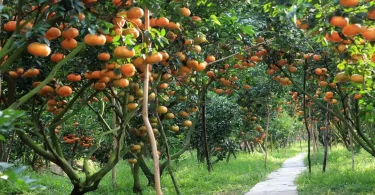Have you noticed a strange white powder coating the leaves of your beloved plants? That telltale dusty, flour-like substance is likely powdery mildew, one of the most common and recognizable plant diseases affecting gardens worldwide. This fungal invader can spread rapidly, weakening plants and reducing yields if left untreated. The good news? With the right knowledge and treatment approach, you can effectively control powdery mildew and restore your plants to health.
In this powdery-mildew-treatment-guide, we’ll explore everything you need to know about powdery mildew treatment – from identifying symptoms and understanding causes to implementing proven prevention strategies and effective remedies. Whether you prefer organic solutions or need stronger chemical options for severe cases, you’ll discover the most effective approaches to tackle this persistent garden problem.
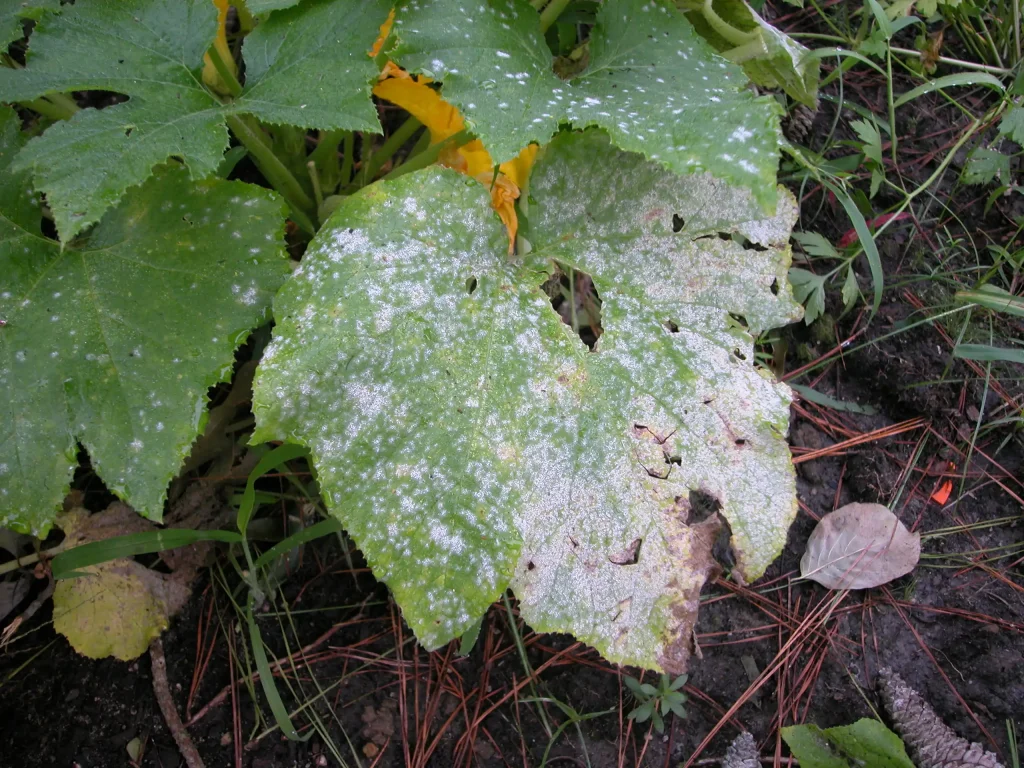
Powdery mildew appears as a white, flour-like substance on plant leaves and stems
What Is Powdery Mildew?
Powdery mildew is a fungal disease caused by various species of fungi (including Erysiphe, Sphaerotheca, and Podosphaera species). Unlike many other plant diseases, powdery mildew doesn’t require moist conditions to thrive – in fact, it often flourishes in warm, dry environments with moderate temperatures between 60-80°F.
This disease affects thousands of plant species, including vegetables (cucumbers, squash, tomatoes, peas), fruits (grapes, apples, strawberries), ornamentals (roses, zinnias, begonias), and even trees. Each plant species is typically affected by a specific powdery mildew fungus, though the symptoms and treatment approaches remain similar.
Key Characteristics of Powdery Mildew:
- Appears as white or grayish powdery spots on leaves, stems, and sometimes flowers
- Thrives in moderate temperatures (60-80°F)
- Prefers shaded areas with poor air circulation
- Can spread rapidly even in dry conditions
- Different fungal species affect specific plant types
Causes & How Powdery Mildew Spreads
Understanding how powdery mildew develops and spreads is crucial for effective prevention and treatment. Unlike many fungal diseases that require moisture for spore germination, powdery mildew can thrive in relatively dry conditions, making it particularly persistent in many garden environments.
Environmental Conditions That Promote Powdery Mildew
Favorable Conditions:
- Moderate temperatures (60-80°F)
- Shaded locations with limited sunlight
- Poor air circulation around plants
- High humidity (but not standing water)
- Overcrowded plantings
Unfavorable Conditions:
- Temperatures above 90°F
- Direct, intense sunlight
- Good air movement around plants
- Extended periods of rainfall
- Proper plant spacing
How Does Powdery Mildew Spread?
Powdery mildew spreads primarily through airborne spores that can travel significant distances on wind currents. These spores are produced in chains on the surface of infected plants, making them easily dislodged and transported. Once they land on a suitable host plant, they can germinate and establish a new infection rapidly, even without free water.
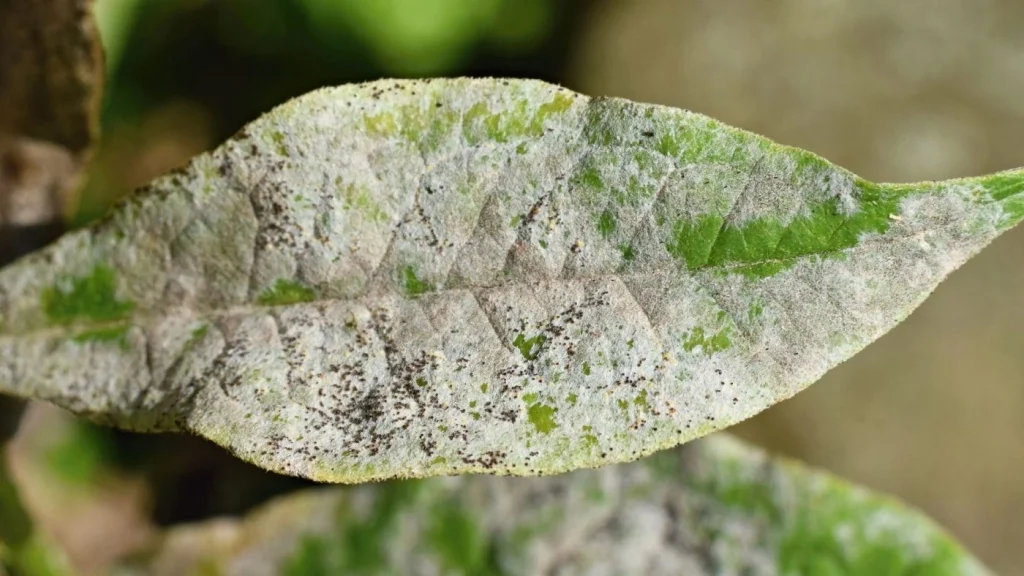
Powdery mildew spores can spread through wind, water splash, and contaminated gardening tools
Common transmission methods include:
- Wind dispersal: The primary method of spread, with spores traveling long distances
- Contaminated tools: Pruners, shears, and other gardening equipment can transfer spores between plants
- Insect carriers: Some insects may inadvertently transport spores as they move between plants
- Human activity: Brushing against infected plants can dislodge spores onto clothing that then contacts healthy plants
The fungus overwinters in plant debris or as specialized resting spores, allowing it to survive harsh conditions and reemerge when favorable conditions return. Some powdery mildew species can also survive on alternative host plants, including weeds, making complete eradication challenging.
Effects of Powdery Mildew on Plants
While powdery mildew rarely kills mature plants outright, it can significantly impact plant health, appearance, and productivity. Understanding these effects helps emphasize the importance of prompt treatment.

Comparison of healthy leaves (left) versus leaves affected by powdery mildew (right)
Common Symptoms and Damage
- Reduced photosynthesis: The white powdery coating blocks sunlight, hindering the plant’s ability to produce energy
- Leaf yellowing and browning: Infected leaves often turn yellow, then brown, and may fall off prematurely
- Distorted growth: New growth may emerge twisted, stunted, or malformed
- Reduced yields: Flowering and fruiting can be significantly diminished in infected plants
- Weakened immunity: Affected plants become more susceptible to other pests and diseases
- Aesthetic damage: The unsightly white patches reduce ornamental value of decorative plants
While powdery mildew rarely kills established plants, severe infections can be fatal to seedlings and significantly reduce the quality and quantity of fruits and vegetables in food crops.
The severity of these effects varies depending on the plant species, the specific powdery mildew fungus involved, the plant’s overall health, and how quickly treatment begins. Early intervention is key to minimizing damage and preserving plant vigor.
Prevention & Control Strategies
Preventing powdery mildew is always easier than treating an established infection. By implementing good cultural practices and creating conditions unfavorable to fungal growth, you can significantly reduce the risk of powdery mildew in your garden.
Cultural Practices for Prevention

Proper plant spacing improves air circulation and reduces powdery mildew risk
- Choose resistant varieties: Many plants now have powdery mildew-resistant cultivars available, particularly for frequently affected species like cucumbers, squash, and zinnias
- Improve air circulation: Space plants properly according to their mature size requirements and prune dense growth to allow air movement
- Provide adequate sunlight: Plant susceptible species in sunny locations whenever possible, as powdery mildew thrives in shade
- Water properly: Water at the base of plants rather than overhead to keep foliage dry, and water in the morning so any splashed leaves can dry quickly
- Avoid excess nitrogen: Too much nitrogen promotes lush, susceptible growth; use balanced fertilizers instead
- Practice good sanitation: Remove and dispose of infected plant material (don’t compost it) and clean tools between plants
Organic Treatment Methods
When prevention isn’t enough and powdery mildew appears, several organic options can effectively control the disease while minimizing environmental impact.
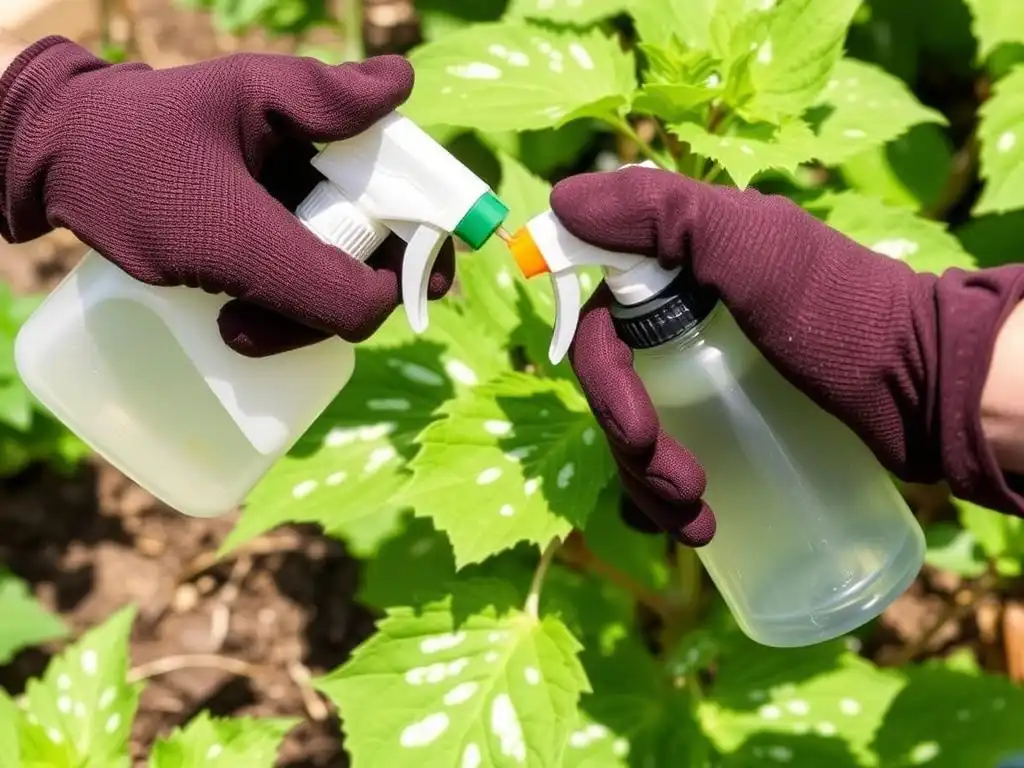
Applying neem oil spray as an organic treatment for powdery mildew
Neem Oil Solution
Neem oil is a natural fungicide that effectively controls powdery mildew while being safe for beneficial insects.
- Mix 2 tablespoons of neem oil with 1 gallon of water and a few drops of mild dish soap
- Spray thoroughly on affected plants, covering both sides of leaves
- Apply every 7-14 days until the infection clears
- Avoid applying in temperatures above 90°F or within 2 weeks of sulfur application
Baking Soda Spray
This household remedy changes leaf pH, making it inhospitable to fungal growth.
- Mix 1 tablespoon baking soda, 1 teaspoon mild liquid soap, and 1 gallon of water
- Apply weekly to affected plants
- Works best as a preventative or for mild infections
Milk Solution
The proteins in milk have antifungal properties that can suppress powdery mildew.
- Mix 1 part milk with 2-3 parts water
- Spray on affected plants twice weekly
- Most effective when applied in morning sunlight
Chemical Treatment Options
For severe infections or when organic methods aren’t providing adequate control, chemical fungicides can offer more powerful solutions.
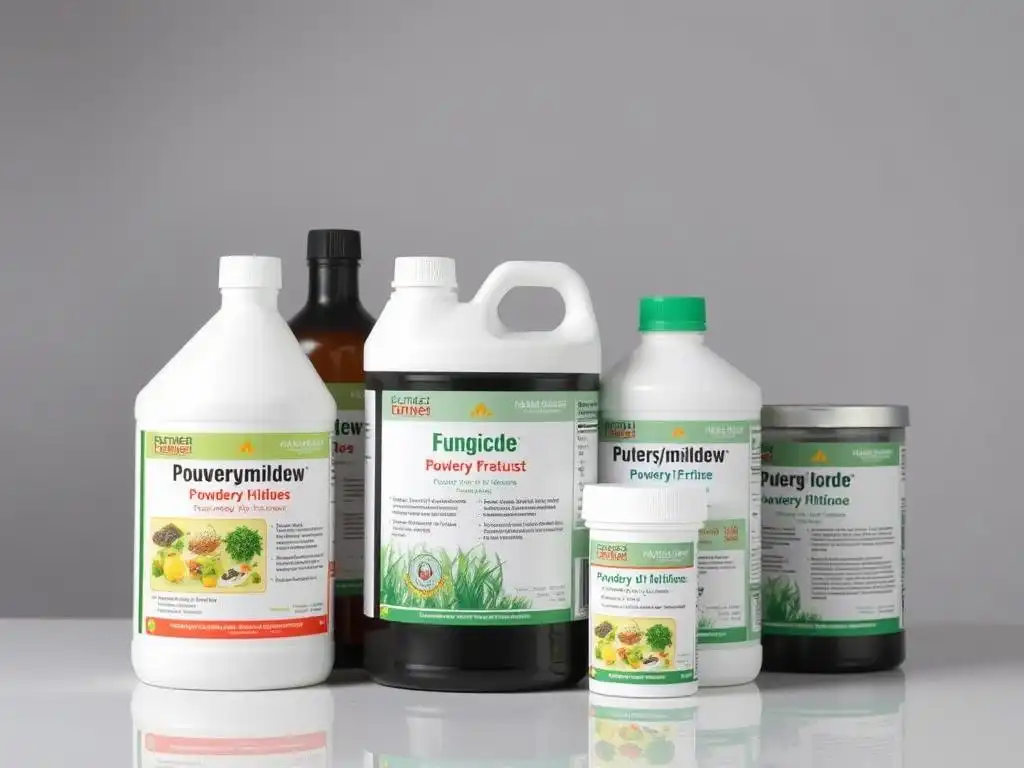
Commercial fungicides formulated specifically for powdery mildew control
Sulfur-Based Fungicides
Sulfur is one of the oldest and most effective fungicides for powdery mildew control.
- Available as wettable powder, dust, or liquid formulations
- Apply before or at earliest signs of infection
- Do not apply when temperatures exceed 90°F
- Wait at least 2 weeks between sulfur and oil applications
| Treatment Type | Effectiveness | Safety Profile | Application Frequency | Best For |
| Neem Oil | Moderate to Good | Very Safe, Organic | Every 7-14 days | Preventative & early infections |
| Baking Soda | Mild to Moderate | Very Safe, Household | Weekly | Prevention & mild cases |
| Milk Solution | Mild to Moderate | Very Safe, Food-grade | Twice weekly | Light infections |
| Sulfur | Good to Excellent | Moderate, Can irritate | 7-10 days | Prevention & established infections |
| Potassium Bicarbonate | Good | Safe, OMRI listed | 7-14 days | Active infections |
| Chemical Fungicides | Excellent | Varies by product | Per label (typically 7-14 days) | Severe infections |
Step-by-Step Powdery Mildew Treatment Guide
Effectively treating powdery mildew requires a systematic approach. Follow these steps for the best results in controlling an active infection.
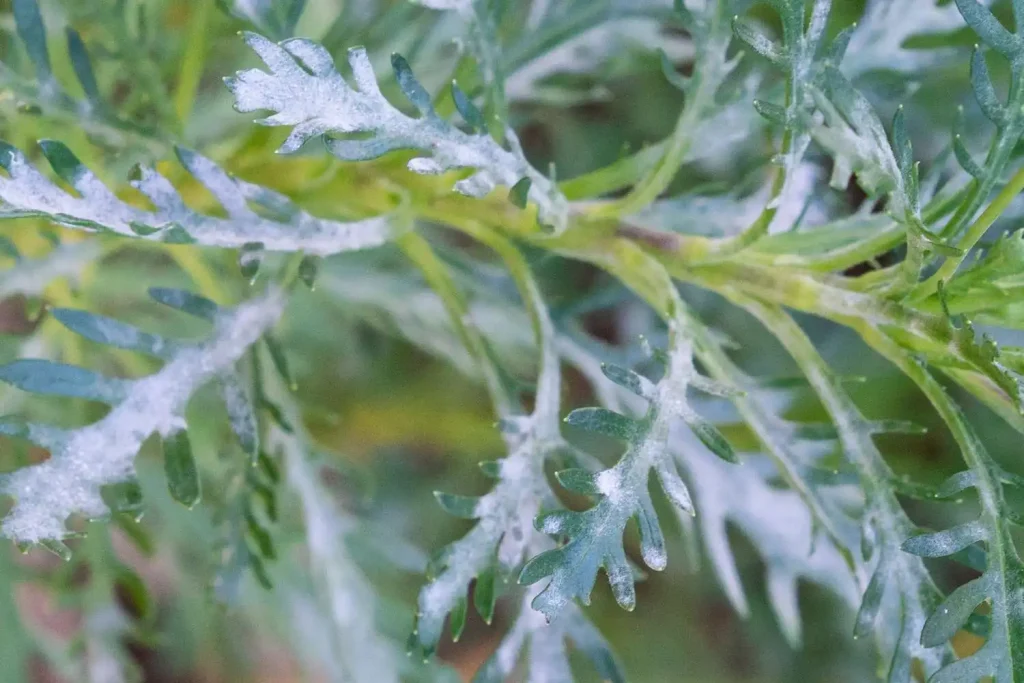
Follow this systematic approach to effectively treat powdery mildew infections
- Confirm the diagnosis: Verify that you’re dealing with powdery mildew and not another disease. Look for the characteristic white, powdery patches primarily on upper leaf surfaces.
- Remove severely infected plant parts: Prune away the most affected leaves, stems, or branches. Seal them in a plastic bag and dispose of them in the trash (not compost).
- Improve growing conditions: Increase air circulation by thinning plants, relocate potted plants to sunnier locations if possible, and adjust watering practices to avoid wetting foliage.
- Apply appropriate treatment: Choose a treatment based on infection severity, plant type, and your preference for organic vs. chemical options. Apply according to product instructions.
- Monitor and repeat as needed: Check plants regularly for signs of recurring infection. Most treatments require repeated application every 7-14 days until the disease is controlled.
- Implement preventative measures: Once the infection is under control, focus on prevention strategies to reduce the likelihood of recurrence.
Important: Always apply treatments in the early morning or evening to avoid leaf burn, especially when using oils or soaps. Never apply treatments when temperatures exceed 90°F or to drought-stressed plants.
Distinguishing Powdery Mildew from Other Fungal Diseases
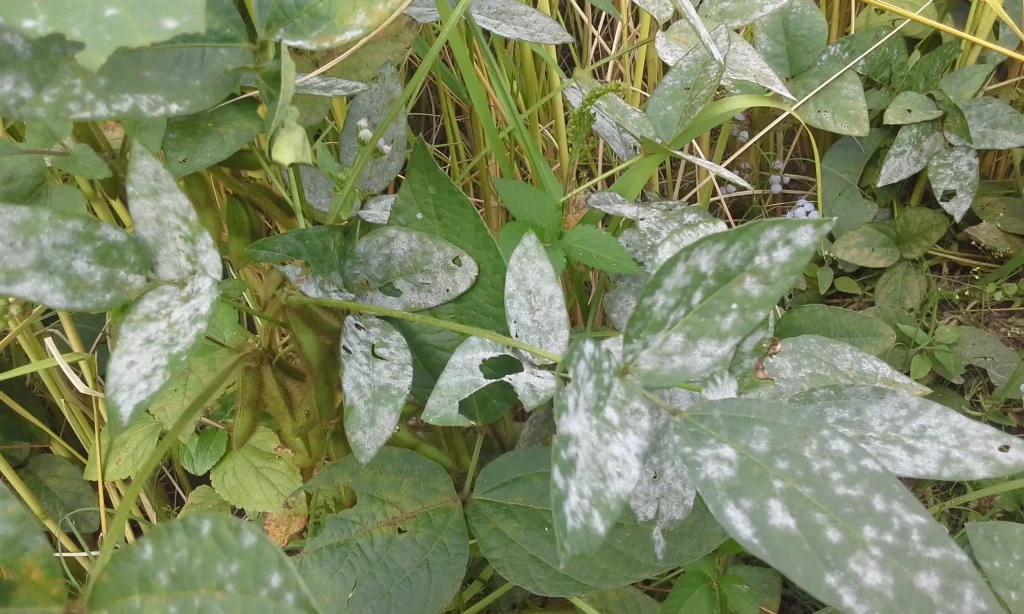
Visual comparison of powdery mildew versus other common fungal plant diseases
Powdery Mildew Characteristics:
- White to gray powdery coating
- Primarily on upper leaf surfaces
- Doesn’t require moisture to develop
- Rarely shows water-soaked lesions
- Develops in dry conditions with high humidity
Similar Diseases:
- Downy Mildew: Yellow spots on upper leaf surface with fuzzy gray growth underneath
- Leaf Spot: Brown or black spots with defined margins
- Botrytis: Gray fuzzy mold with water-soaked areas
- White Rust: White or yellowish pustules that rupture
Resistant Plant Varieties
One of the most effective long-term strategies for managing powdery mildew is planting resistant varieties. Many seed companies and nurseries now offer cultivars specifically bred to resist this common disease.
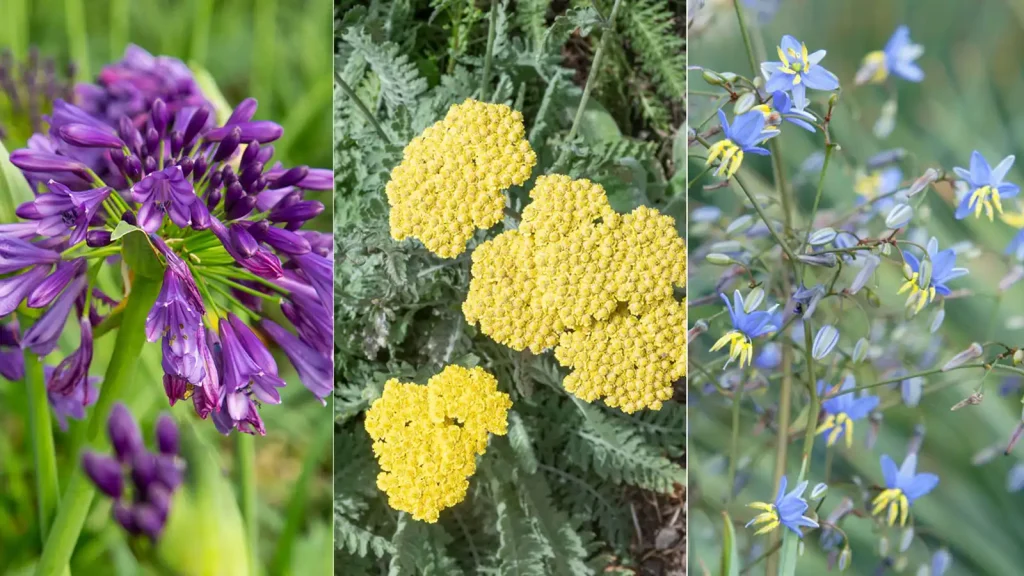
Resistant varieties (right) remain healthy even when susceptible varieties (left) show infection
Recommended Resistant Varieties by Plant Type
Vegetables
- Cucumber: ‘Marketmore 76’, ‘Salad Bush’, ‘County Fair’
- Squash: ‘Butterbush’, ‘Early Summer Crookneck’, ‘Success PM’
- Peas: ‘Green Arrow’, ‘Oregon Sugar Pod II’, ‘Maestro’
- Tomatoes: ‘Sungold’, ‘Mountain Magic’, ‘Juliet’
Flowers
- Zinnia: ‘Zahara’ series, ‘Profusion’ series
- Phlox: ‘David’, ‘Bright Eyes’, ‘Flame’ series
- Bee Balm: ‘Marshall’s Delight’, ‘Raspberry Wine’
- Roses: ‘Knock Out’ series, ‘Carefree Beauty’
Fruits
- Grapes: ‘Mars’, ‘Reliance’, ‘Concord’
- Apples: ‘Liberty’, ‘Enterprise’, ‘Williams Pride’
- Strawberries: ‘Earliglow’, ‘Allstar’, ‘Jewel’
- Melons: ‘Hannah’s Choice’, ‘Passport’, ‘Honey Brew’
Find Powdery Mildew-Resistant Seeds
Start your garden right with disease-resistant varieties that naturally fight powdery mildew. Browse our collection of specially selected seeds that combine excellent flavor and yields with strong disease resistance.
Frequently Asked Questions About Powdery Mildew
Can powdery mildew kill plants?
While powdery mildew rarely kills mature, established plants, severe infections can be fatal to seedlings and young plants. In most cases, powdery mildew weakens plants by reducing photosynthesis, causing premature leaf drop, and stunting growth. This stress makes plants more susceptible to other problems and can significantly reduce yields in food crops. Without treatment, a severe infection can eventually lead to plant death, particularly in highly susceptible varieties under stress conditions.
Is white plant fungus contagious?
Yes, powdery mildew is highly contagious between plants of the same or related species. The fungal spores spread easily via wind, water splash, insects, and gardening tools. However, most powdery mildew species are host-specific, meaning the powdery mildew affecting your cucumbers won’t spread to your roses, as they’re caused by different fungal species. Still, good sanitation practices are important to prevent spread within plant families.
What’s the best homemade spray for powdery mildew?
The most effective homemade spray for powdery mildew is a combination of baking soda, horticultural oil, and mild soap. Mix 1 tablespoon of baking soda, 1 teaspoon of horticultural oil (or neem oil), and a few drops of mild liquid soap in 1 gallon of water. This solution changes the leaf surface pH, making it inhospitable to fungal growth, while the oil helps the mixture adhere to plant surfaces. Apply weekly in the early morning or evening for best results.
How quickly does powdery mildew spread?
Powdery mildew can spread surprisingly quickly under favorable conditions. Once established, a new generation of spores can be produced within 3-7 days, allowing rapid colonization of susceptible plants. In ideal conditions (moderate temperatures, high humidity, but dry leaf surfaces), powdery mildew can spread throughout a plant and to neighboring plants within 7-10 days. This rapid reproduction cycle makes early detection and prompt treatment essential.
Can I compost plants with powdery mildew?
It’s generally not recommended to compost plants heavily infected with powdery mildew. Home compost piles often don’t reach temperatures high enough to kill all fungal spores, which can survive and infect plants when the compost is later used. Instead, seal infected plant material in plastic bags and dispose of it in the trash. If you have only lightly infected material and maintain a hot compost system (reaching 140°F), the spores may be destroyed, but this isn’t guaranteed.
Protecting Your Garden from Powdery Mildew
Powdery mildew may be a common garden challenge, but with the right approach, you can effectively prevent and treat this persistent fungal disease. By implementing good cultural practices, choosing resistant varieties, and having effective treatment options ready, you can minimize the impact of powdery mildew on your garden’s health and productivity.
Remember that prevention is always easier than treatment. Focus on creating conditions unfavorable to fungal growth through proper spacing, adequate sunlight, and appropriate watering practices. Monitor your plants regularly for early signs of infection, and act quickly at the first appearance of those telltale white spots.

A healthy garden maintained with good cultural practices is your best defense against powdery mildew
Whether you prefer organic remedies like neem oil and baking soda solutions or need the stronger protection of commercial fungicides, having a treatment plan ready will help you respond effectively when powdery mildew appears. With consistent attention and the strategies outlined in this guide, you can keep your plants healthy and powdery mildew at bay.

